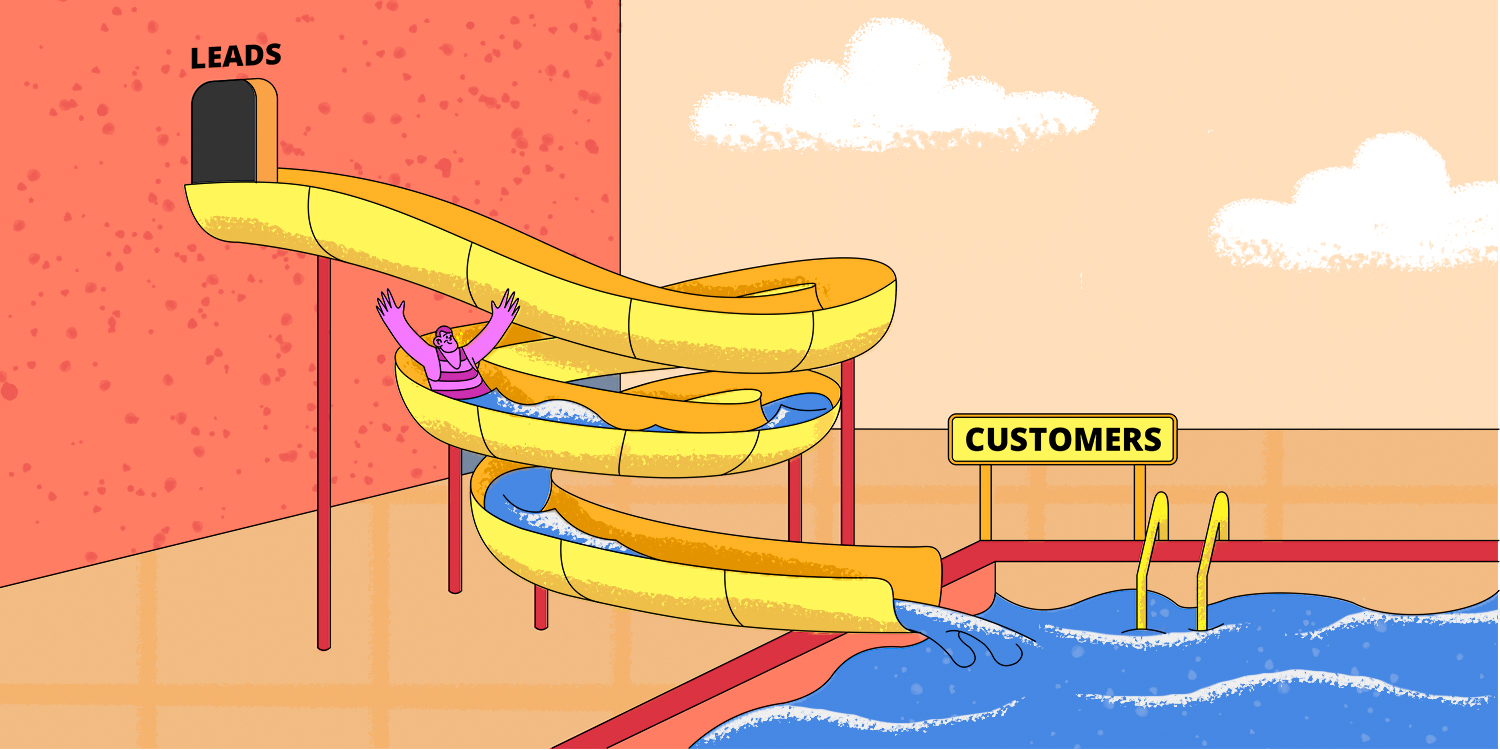Imagine having a “magic” mechanism that collects traffic from various online channels and transforms it into money that goes directly to your company’s cash flow.
Did you know this is possible? A well-modeled sales funnel enables you to easily drive traffic, generate leads, and nurture them based on where they are in their buyer’s journey. As a result, you obtain ultra-hot ready-to-buy leads.
After reading this article, you will learn how your business can benefit from creating sales funnels, know what stages to include, and get free funnel templates for various marketing and sales strategies.
Outline:
What is a sales funnel?
A sales funnel, sometimes also called a conversion funnel, is a series of steps your prospects go through before they reach the point of completing the purchase.
At each stage, there is a different type of content produced that targets buyers as they go through that purchasing process. Content at the bottom of the funnel is designed to drive conversions and encourage the final purchase decision, where as content at the top of the funnel aims at creating awareness and attracting potential customers.
It was first developed at the end of the 19th century by St. Elmo Lewis, and followed the AIDA model, which stands for Awareness, Interest, Desire, and Action. These four stages can be explained as follows:
- Awareness — the stage when the customer learns about the product.
- Interest — the stage at which the customer becomes interested in the product.
- Desire — the stage when the customer demonstrates preferences in terms of products and brands and develops a desire to buy the chosen solution.
- Action — the stage at which the customer wants to try the product (they either start a trial or make a purchase).
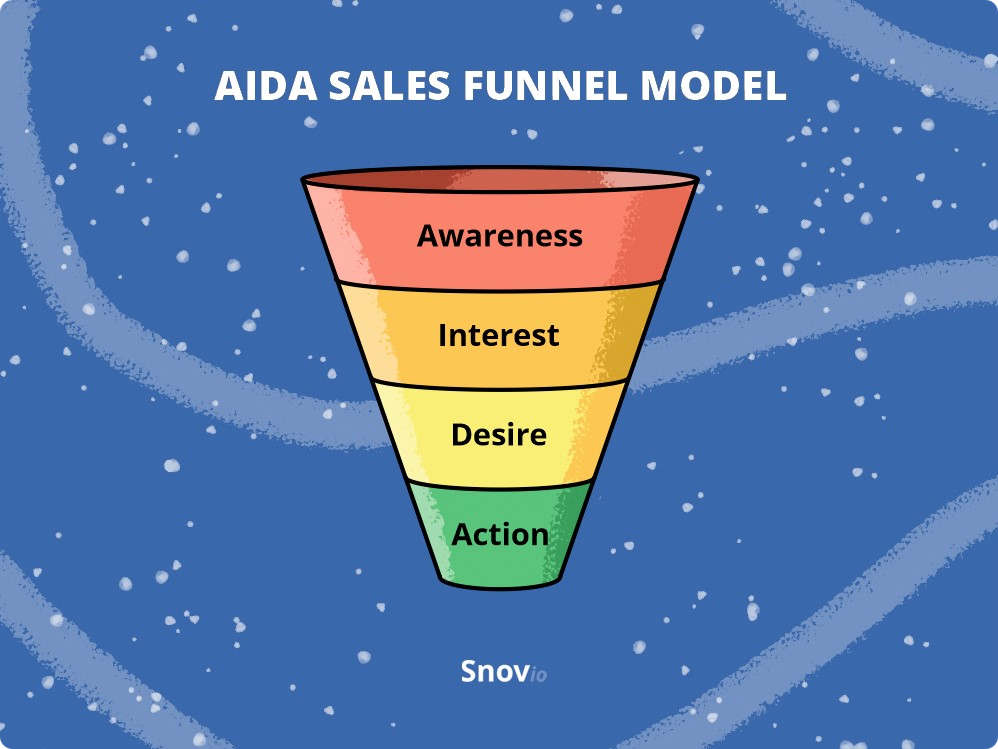
Nowadays, this model has been reconsidered and expanded.
Let’s look at the basic structure of a modern B2B sales funnel.
Basic structure of a B2B sales funnel
The basic funnel structure has three levels: top, middle, and bottom of the funnel.
Top of the Funnel (TOFU)
It’s the widest section of the funnel as it contains both leads that haven’t interacted with your company yet, as well as leads that have had some type of contact with your brand, product, or service.
This phase is based on bringing awareness about your product. In other words, there’s no demand and no interest yet. Your mission is to create both!
When you reach out to your audience, you start arousing the customer’s interest. From here on, the challenge is to nurture that potential customer and drive them to the middle of the funnel.
Middle of the Funnel (MOFU)
This is a consideration stage when leads are evaluating how your product or service can fit their needs.
Some of them may become your marketing-qualified leads — people who have shown interest in your marketing actions but aren’t ready for your sales pitch yet.
Some might turn into sales-qualified leads — those who actively want to make a purchase and should be pursued for conversion into paying customers.
Bottom of the Funnel (BOFU)
You’ve worked hard to get prospective customers to the bottom of the funnel, helping them choose your company as the best option for their demands. Now they’ve become your opportunities or qualified leads with the highest potential of buying your solution.
At this stage, they are going to make a purchase decision. It’s time you prove your value and build trust so that they become your customers.
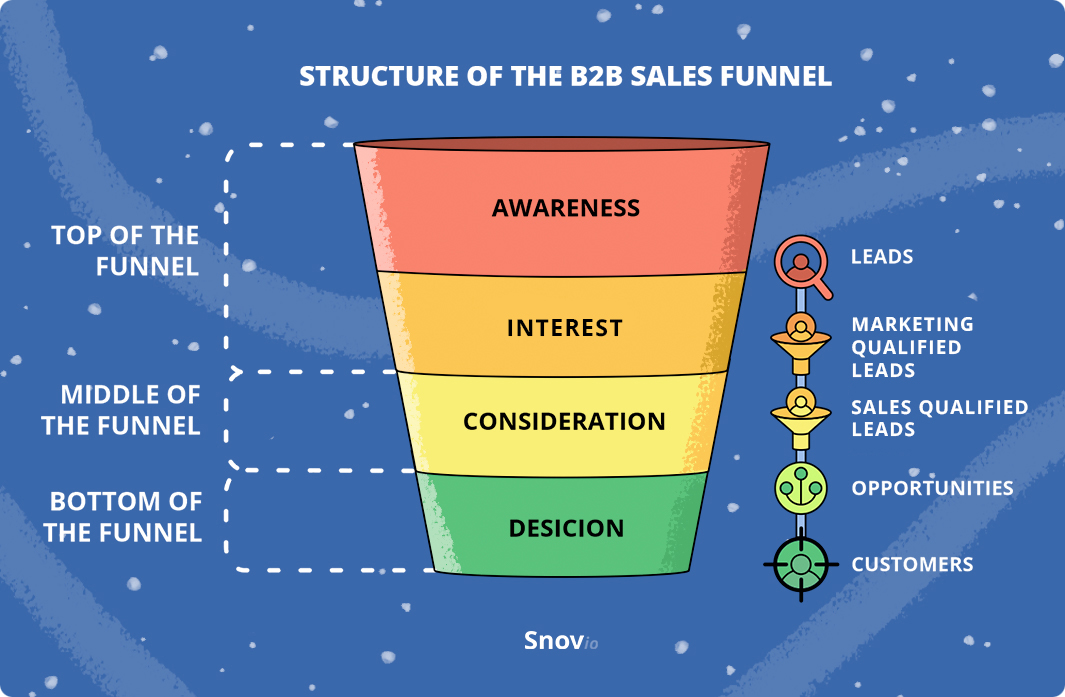
As you read more about this topic, you’ll find more versions of the funnel with different sales stages. For example, some specialists add the fifth loyalty stage that refers to customer satisfaction after the purchase and focuses on maintaining a lasting, loyal relationship with your customers.
Sales funnel vs. marketing funnel: what’s the difference?
The term sales funnel is often mixed with another similar term — marketing funnel.
Traditionally, B2B sales was a linear process, which presupposed that first, the buyer was introduced to the company by marketers. A marketing funnel was meant to help leads get acquainted with the brand. As soon as they were well educated and ready to consider the solution, sales reps came into action, so the sales funnel was just a continuation of the marketing funnel.
Nowadays, the linear sales process is obsolete. Buyers have become more educated, often coming into the sales game with some baggage of knowledge about the company and its product. This made drawing a line between marketing and sales funnels more difficult.
The business world was quick to find a new approach called smarketing that proposed another way of collaboration — both marketing and sales teams started aligning their effort to ensure the sales process ends in a closed-won deal.
And to make things easier, in this post, we’ll talk about a sales funnel from the sales and marketing alignment perspective.
Why are sales funnels important?
Experts claim that out of all leads you collect, only 10-15% become customers. So, building an effective sales funnel is necessary to grow this percentage.
Let’s take a look at some of the main benefits you’ll get from having one for your sales process:
- Higher productivity. When you know how many prospects are not ready to buy your offering and what prevents them from purchasing from you, you better understand your ideal customer and stop wasting your time on unqualified leads, increasing your overall productivity.
- Better forecasting. Monitoring the results of the prospect’s actions at each funnel stage enables you to predict sales success. Say, you can start understanding how many leads you need to attract to generate sales, etc.
- Stronger customer relations. With a sales funnel in place, you can see what prevents leads from moving to the next stage, understand their needs, and find ways of strengthening your relations.
- Insights for product development. Knowing what prospects expect at every stage of the sales funnel gives you a better vision of how to improve your service or product.
- Higher ROI. Crowning all the above-mentioned benefits, sales funnels help you resell your product and increase your ROI since building them once, you can run many processes automatically.
With so many advantages, there’s no doubt you need to focus your attention on creating sales funnels that will boost your sales. We’ll help 🙂
Top funnel templates for your marketing and sales campaigns
We’ve collected 10 templates for your sales and marketing campaigns, so don’t hesitate to use them as a reliable source for building your sales funnels.
1. Product promotion sales funnel template
This funnel template comes in handy when you 1) want to encourage potential customers who haven’t expressed interest in your product yet; 2) want your current customers to buy more.
You can start the funnel with a low-ticket item to catch their attention. This can be a free trial, a free demo, an inexpensive monthly subscription plan, etc.
After customers make this first small purchase or use your product sample, you qualify them and follow with upselling. Here you should offer them an irrefutable proposition, e.g., a discounted price, and explain how much they are saving and what added value they can gain.
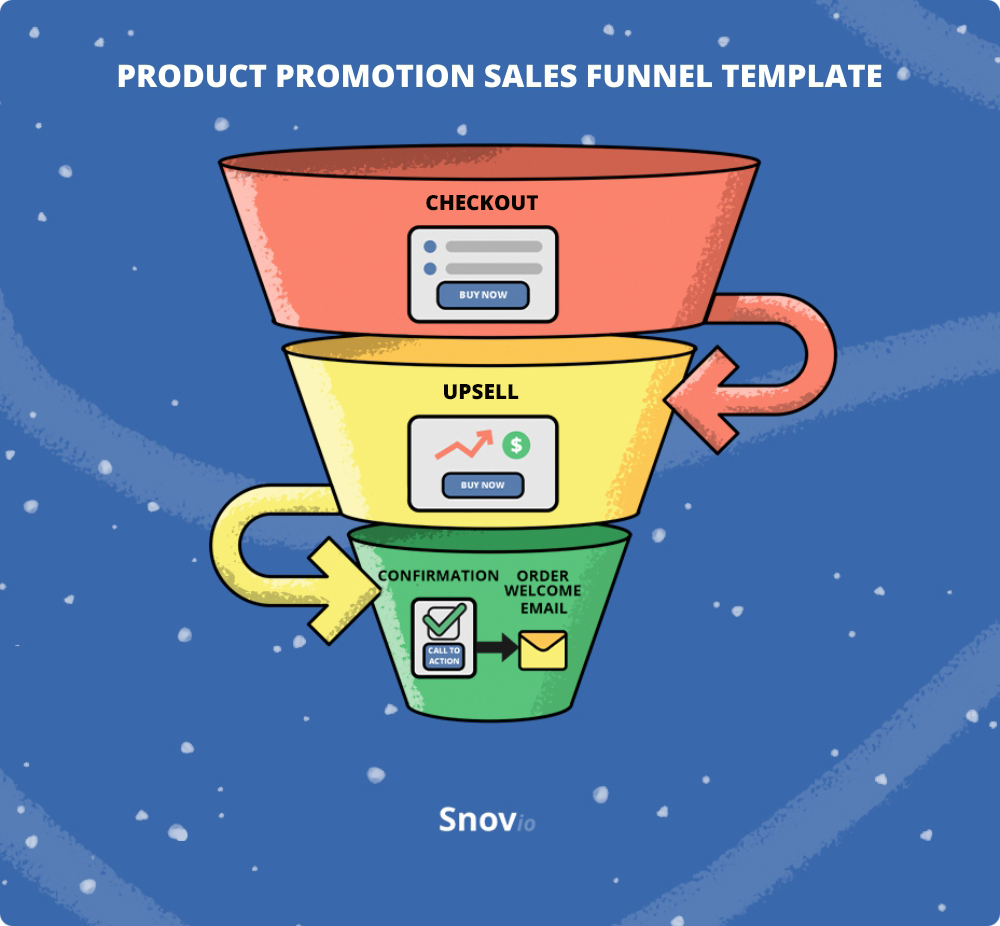
If you are a start-up business with a limited budget that can’t afford paid ads for product promotion, you can opt for alternatives such as a product landing page or social media.
2. Lead magnet sales funnel template
Generating leads is not an easy task. If your company uses an inbound approach, a lead magnet sales funnel template will be of much help. Let’s look at it step by step.
First, you need to create something that you’ll offer your website visitors for free, e.g., a case study, a whitepaper, an ebook, or a detailed industry report — in return for their contact details.
After your visitors have submitted their email addresses, send them a ‘Thank you’ email with a promised freebie. Now you have a list of leads you can nurture with relevant content and compelling offers.
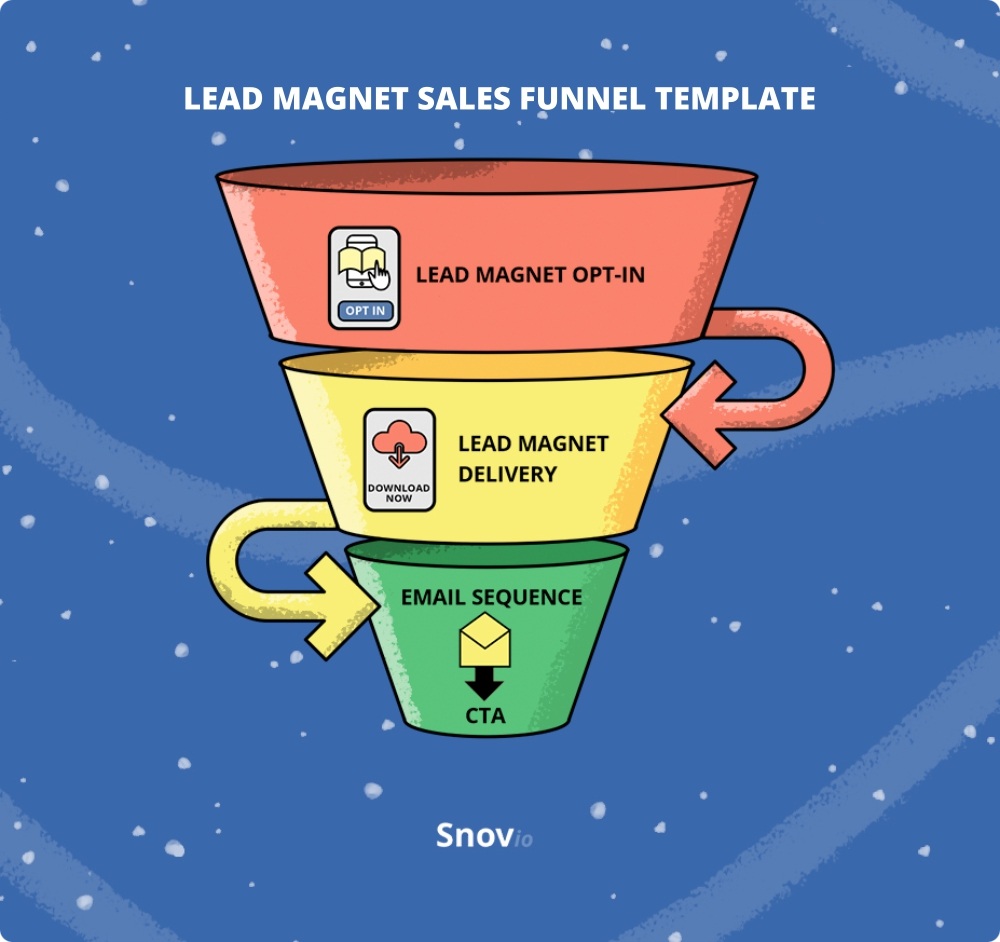
3. Product launch sales funnel template
You can use lead magnets for product launches too!
For example, this template below starts with an opt-in form that guarantees your prospects will receive high-quality promo content, like an email with a sales video attached, in exchange for their contact details.
The next step will be sending 3-4 educational videos with useful, practical information about your product, how it works, and how a customer can benefit from it. Just keep in mind that these videos should provide real value to the prospect.
This will help you build rapport with your potential customers and grow your relations to the level where they will be more apt to buy your freshly launched product or service.
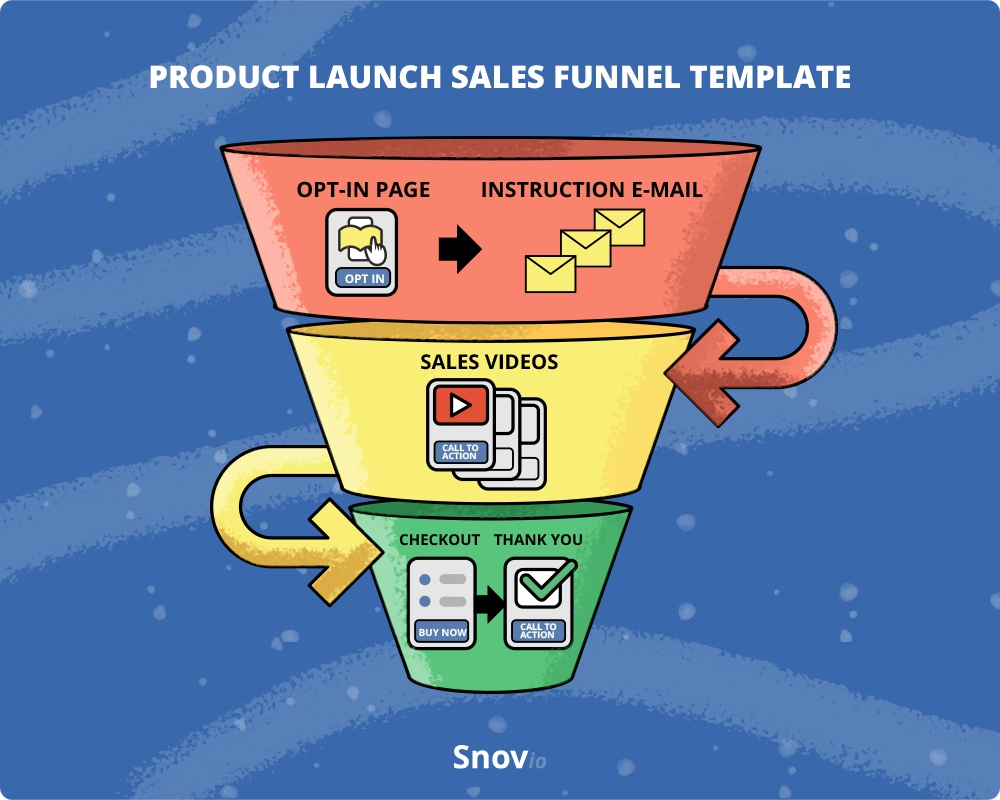
4. Webinar sales funnel template
Serving as a good means to generate high-quality leads, webinars are a goldmine for sales and marketing specialists!
First, your website visitors provide their contact details upon signing up for your webinar. Next, you immediately send them a confirmation email where you thank them for their interest.
Then you hold a webinar and send a recorded version to all the people who subscribed. And here’s where your CTA strikes: mention your product in your follow-up email, inviting webinar attendees to check it out. If they can solve their pain points with it — they won’t resist purchasing it.
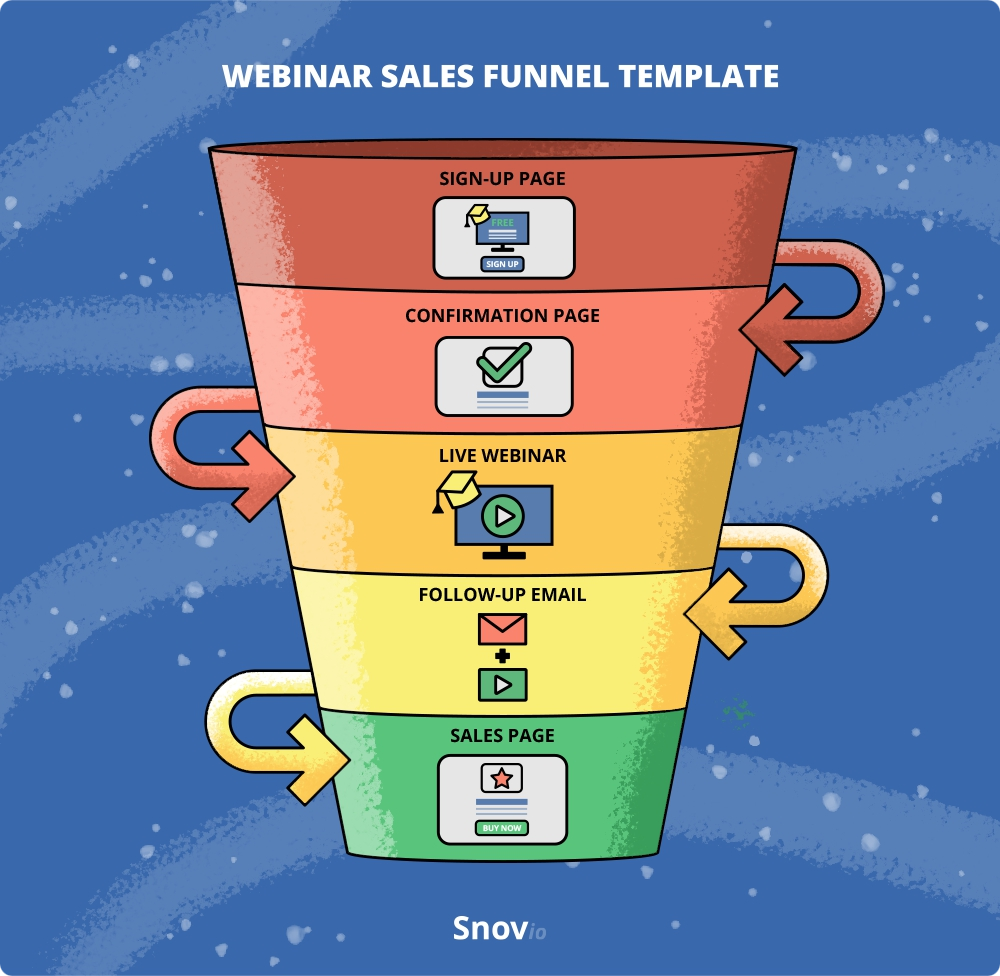
5. Live demo sales funnel template
This funnel template helps you sell by adding live demo videos of how your product works to your website. All you need to do is create a Live Demo page with the recorded live Q&A videos and link it to the Subscription page where you can offer a limited-time proposition to those leads who’ve watched the Q&A videos until the end.
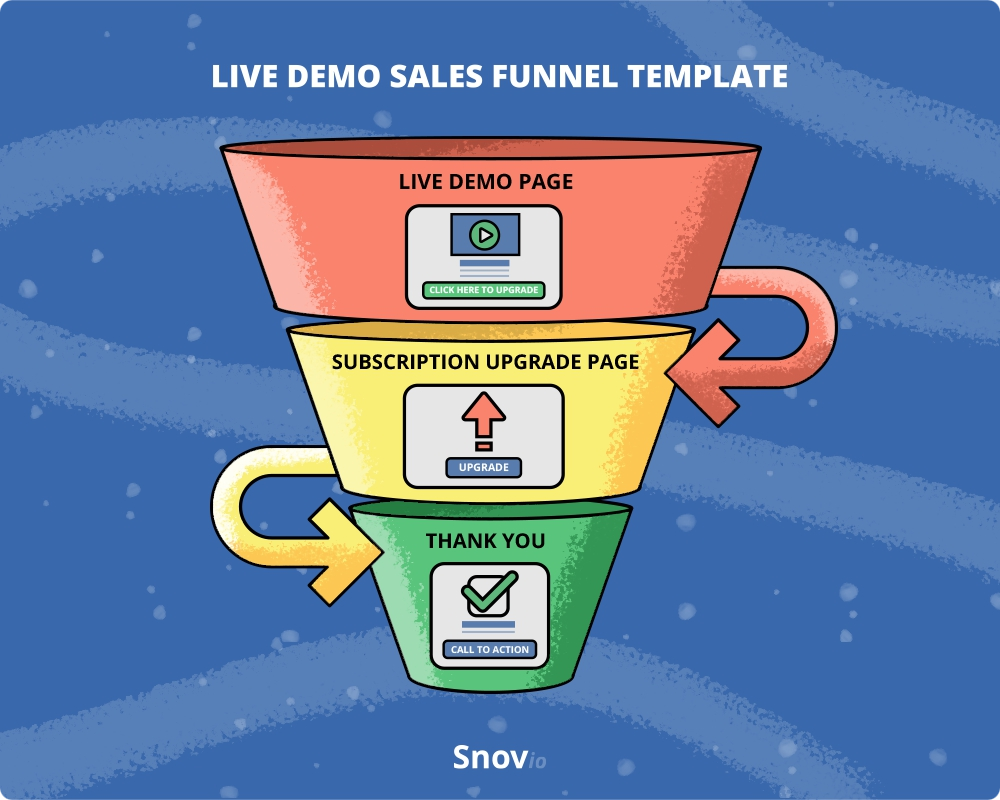
6. High-ticket sales funnel template
Selling high-ticket products such as premium software or a consulting service can be a daunting task. The price of a deal is too high for a customer to make an impulse decision. In this scenario, it would help if you built a sales funnel that will consist of several well-thought-out steps.
First, create an online event page (by the way, the above-mentioned webinar can be a good solution!) where visitors can register and leave their email addresses.
Then send your visitors a follow-up email with a ‘thank you’ message, providing them with a link to the online event.
The online event itself should be well-prepared to highlight your product’s real value and benefits and encourage visitors to move to the next level.
At the end of the online event, redirect visitors to the call-to-action page where you won’t necessarily push them to buy a product immediately. Instead, you can ask them to pay a small deposit for the product if they’ve already decided to purchase it.
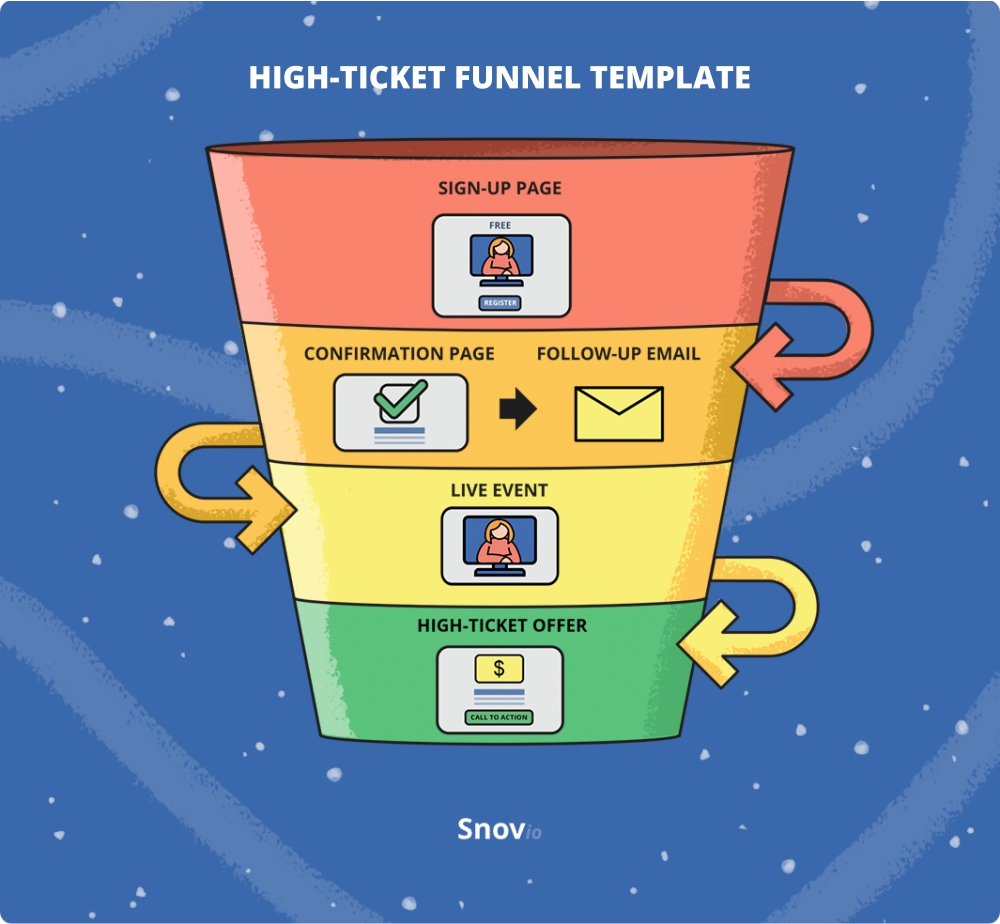
7. Tripwire sales funnel template
Contrary to high-ticket offerings, a tripwire is a low-priced offer. The main goal here is to turn a prospect into the customer and prepare them for a bigger, more expensive proposition. As a rule, this must be a valuable product you’re selling at a compelling price.
But there’s another good thing about making a tripwire sales funnel — even if it doesn’t result in selling a more expensive product, it will enrich your email list with new leads as upon ordering a tripwire product, your target customers will have to leave their email addresses.
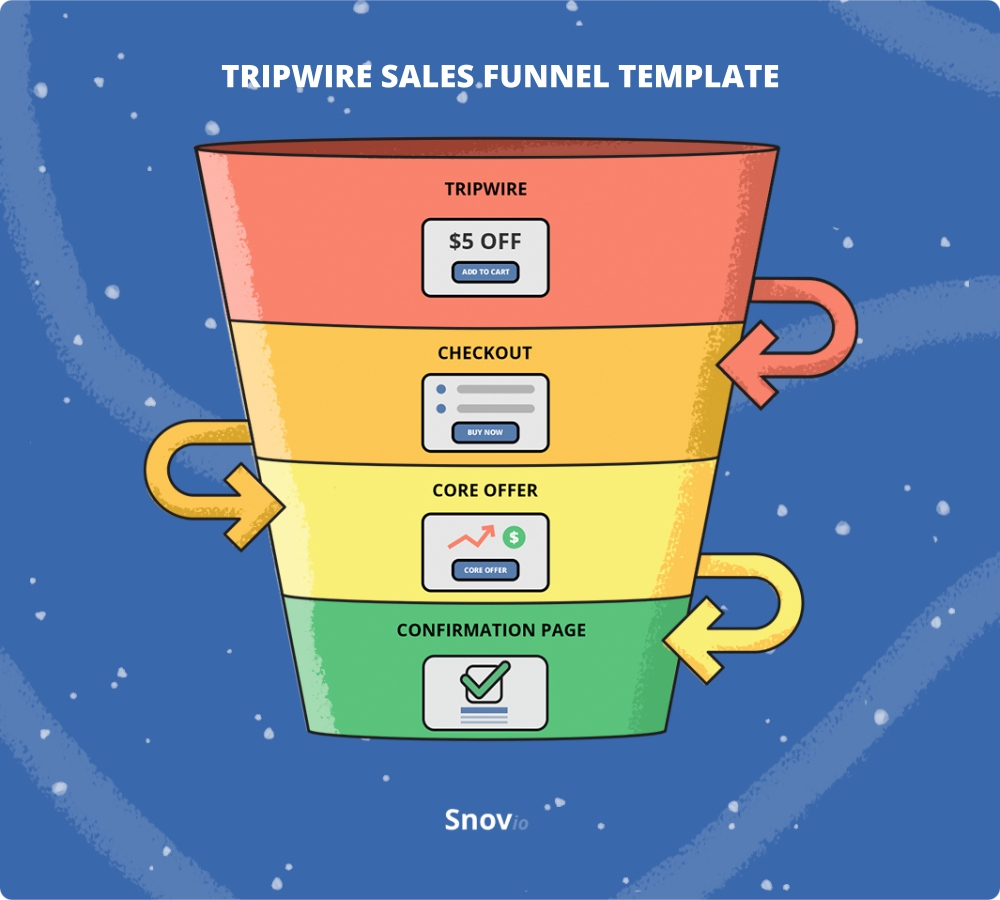
8. Social media + email sales funnel template
You can drastically boost sales If you combine the power of your social media and email marketing strategies.
For example, you can start with a social media post where you’ll invite your followers to an online event. In addition to a social media post, send an invitation email to your subscriber list to drive more interest in your event.
At the end of the event, redirect visitors to the call-to-action page where you’ll offer them your main product.
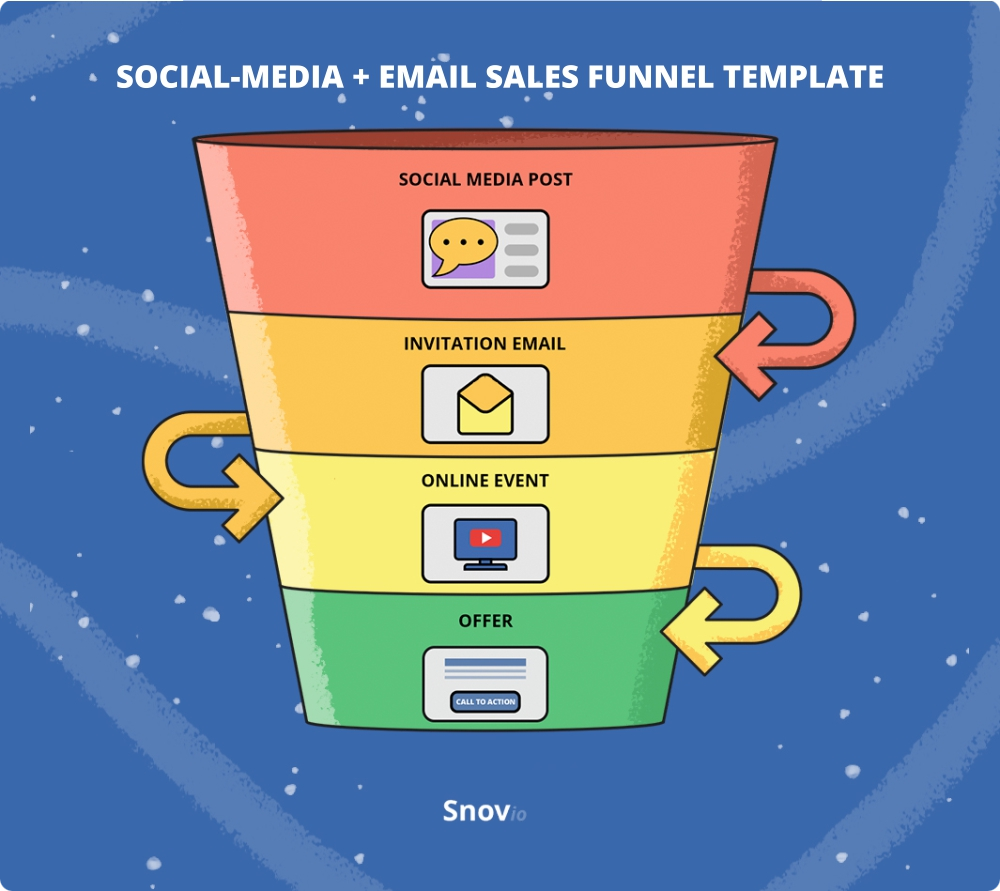
9. Personalized pricing plan sales funnel template
This funnel template will suit SaaS companies that provide services to small businesses that can’t afford large-scale solutions.
Start your sales funnel on a product landing page, where potential customers can choose between two CTAs: whether they start using your product by providing their contact data (and automatically joining your prospect list) or get redirected to the pricing plan page.
On the pricing plan page, you can highlight several pricing plans to compare and offer users a personalized pricing plan based on the number of their contacts.
This way, you’ll provide them with an option to save their costs, thus increasing your chances of converting them into customers.
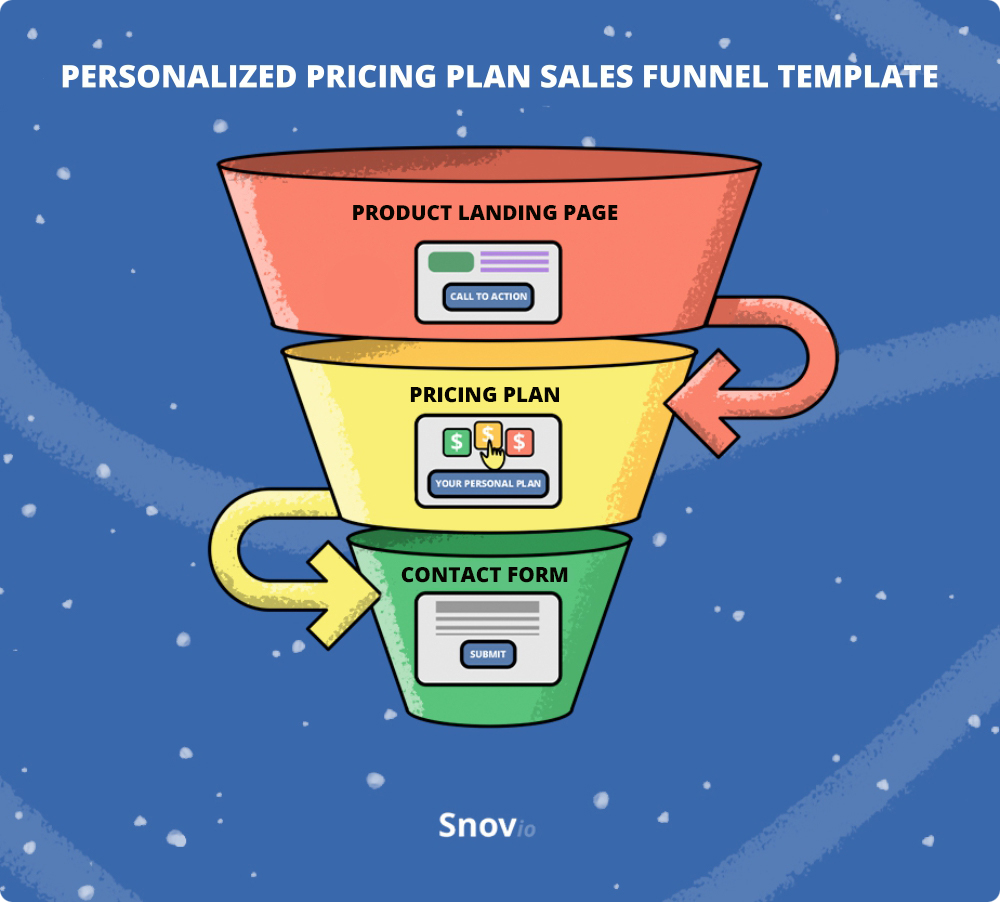
10. Cancellation sales funnel template
This funnel template is used as a saving boat when a user wants to cancel the subscription. To retain them, start with a Survey page aimed at finding out the reasons for cancellation. Then you should make an irresistible offer for them to stay. For instance, this can be a discount on their plan for the next month.
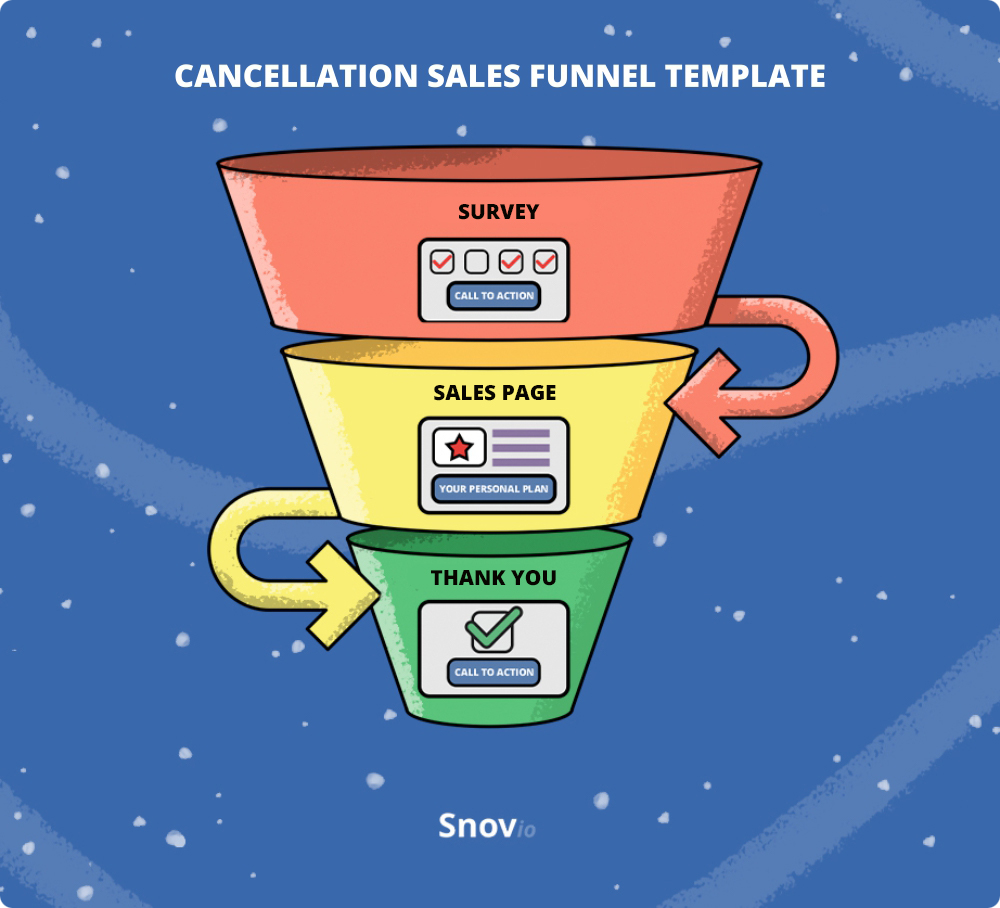
Sales funnel elements
As you might’ve noticed, most sales and marketing funnel templates consist of similar small elements that make sales funnel patterns.
Let’s take a closer look at the most common of them:
Ads. Paid ads bring you leads via Google or social media platforms (like LinkedIn or Facebook). This is the crucial step for every sales funnel, as it fuels your system with leads. But if your business can’t afford paid advertising, there are other ways to build brand awareness, e.g., email marketing, video advertising, audio channels, etc.
Lead magnet. Your leads are usually brought from ads to the landing page. Most often, the page contains a lead magnet that offers some value for free (coupon, webinar, ebook, etc.) in exchange for the contact info of your lead. This way, you can obtain the prospect’s email address to keep moving them down the sales funnel.
Thank You (TY) / Congratulations page. Once your prospective customer downloads a lead magnet file (book, presentation, etc.), they’ll be forwarded to a TY-page or Congratulations page, which works well for boosting the leads’ enthusiasm to keep moving toward the purchase.
Long-form sales page. The TY-page should lead your prospect to a Lead Gen/Long-Form Sales page that contains all the best elements of a standard sales page. This way, there’s no need to worry that leads might drop out of your sales funnel.
Checkout page. After the long-form sales page, prospects interested in your offer will be redirected to a checkout page to complete the purchase.
After-checkout email follow-up. After a person schedules a call or buys your product, they should get a follow-up email sequence. Its goal is to keep nurturing your customers even after the purchase has been accomplished. This way, your offer can bring them even more value and help you turn existing customers into repeat buyers and brand ambassadors.
How to create a high-converting sales funnel: actionable tips to consider
Now that you’ve been provided with some handy sales funnel templates, let’s crown the post with effective tips on how to build your sales funnel like a pro. Keeping these small rules in mind, you’ll be more confident while creating funnels for your sales and marketing campaigns.
Know your ideal customer
Analyze your potential customers and create an ideal customer profile to ensure you’re building your sales funnel around people who have a high probability of purchasing your product or service. Consider their buying behavior and firmographics so that you understand what your potential customer needs, which communication channels they prefer, what’s the best source of your leads, etc.
Personalize your customer’s journey
Moving from stage to stage of your sales cycle, always remember that at each stage, your customers expect to have a positive experience with your brand. Personalization allows you to build connections with the prospect in the best way.
Drive traffic to your website
Startup companies that don’t have big sums of money to invest in advertising should focus on how to draw the attention of their potential customers to the website. Otherwise, lead magnets and perfectly designed product pages will remain invisible.
You can drive more traffic to your website through SEO, blog and guest posting, email marketing campaigns, whatnot. Just remember that you won’t make a horse drink the water unless you lead it to the water.
Incorporating top design terms can significantly enhance the visual appeal of your website and capture the interest of your target audience.
Engage your customers
Lighting a fire is one thing; another thing is to keep the fire going. The same with your customers. Never rest engaging with them from the first stage of the sales funnel.
You can do it in multiple ways, for example:
- Write engaging blog articles that will ignite your customer’s interest and comments.
- Create educational content, especially videos that will tell your customers about your product or service in an interactive way.
- Use social media where you can both promote your product and interact with your customers.
Use sales automation tools
As soon as your customer base grows, things will go crazier, so you’ll feel a strong need to better control your sales funnels. Leads’ entering the sales pipeline, moving from stage to stage, turning over, and converting may become a real mess you’ll find difficult to manage manually.
So, whatever complex your sales cycle is, you should find a reliable marketing and sales automation tool. And this is where Snov.io can become your best friend. It offers a free CRM, is an ideal option for startups, plus boasts of an advanced toolkit for lead generation and sales outreach.
Bottom line
Having a sales funnel in front of your eyes alleviates all the pain you might have got from organizing your sales routine. We hope the sales funnel templates we’ve provided in this post will help you create your own powerful sales funnels for any occasion.
And when it comes to automating your tasks, remember to pick a reliable tool for sales automation like Snov.io and enjoy seeing how well your sales funnels work in practice.
